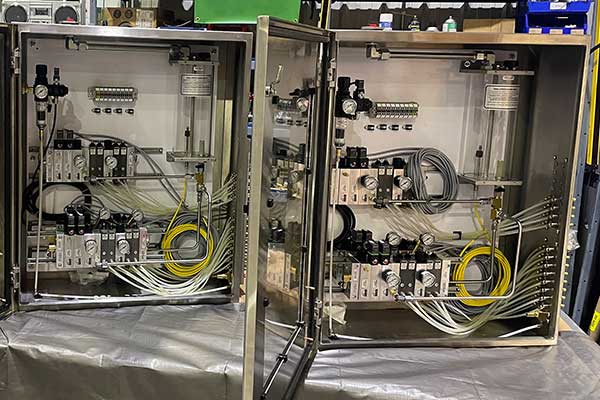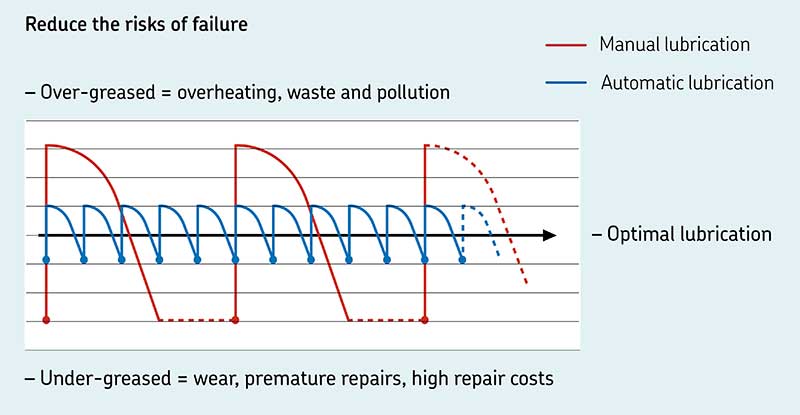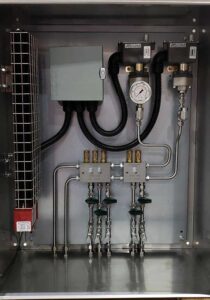Auto-Lube Systems Extend Asset Life
Auto-Lube Systems Extend Asset Life

A properly designed auto-lubrication system can mitigate a range of factors that lead to premature failure.
Automated lubrication systems have been commonly used for decades. These systems have saved end users countless fortunes by reducing maintenance costs and limiting unscheduled downtime. An estimated 50% of all premature bearing failures are attributed to lubrication or contamination issues. These include under/over lubrication, excessive/limited application intervals, incorrect lubricant type, contamination from water/air/particulates, and cross-contamination from mixing incompatible lubricants. All of these factors contribute to premature failure and can be mitigated with a properly designed auto-lubrication system.
The heart of this technology is its ability to predictably and reliably lubricate on an adjustable interval. This optimized lubricant application, as opposed to the non-frequent type (often experienced when manually lubricating equipment), has many benefits.
The greatest of these benefits is the system’s ability to efficiently maintain the proper lubrication film required to reduce wear. These systems can also reliably purge contamination from pins, bushings, and seals. An often-overlooked feature, this prophylactic ability to protect against the egress of contaminants can be a real asset, particularly in extreme environments. When used effectively, this purging feature can help extend equipment life in the most severe conditions.
Automated lubrication technology enables predictable and reliable greasing on an adjustable interval. Image courtesy SKF
Lubricant integrity is another key benefit of automated lubrication systems. Failures due to contamination from water/air/particulates and cross-contamination from mixing incompatible lubricants often result from human error. Having a self-contained, closed-coupled means of storing, transporting, and applying grease helps to protect the lubricant’s integrity and, subsequently, the asset being lubricated.
Automated grease systems reduce maintenance costs over time and extend asset life. Most automated systems will have a positive return on investment (calculated solely in labor savings) of several months to a few years. When calculating the benefits of reduced downtime and extended equipment life, the payback quickly overshadows the purchase cost.
This auto-lube panel was installed into a prefabricated frame on a food-industry oven. Image courtesy Motion
The common system types, ranked from lowest initial cost and level of complexity to highest, include:
- Single Point
- Progressive
- Single-Line Parallel
- Dual-Line Parallel.
Dual-line systems are, by far, the most robust, reliable automated lubrication systems and service most of the large, complex industrial equipment in harsh environments.
At the heart of most automated lubrication systems today lies some tried-and-true technology that is reliable and flexible in its application. Although many advances in component design, material science, and packaged control systems have been made over the years, we are on the precipice of a renaissance in how these systems are controlled. Recent innovations in sensor technology, IIoT proliferation, and machine learning have led to an exponential growth in control system complexity and utility across all industry segments. This leap forward is entering the automated lubrication systems world and has many manufacturers developing or augmenting their portfolios.
Sensor advances
An automated dual-line grease dosing panel is used to service a large conveyor tail pulley in the Alberta oil sands. This system was tied directly into the end user’s DCS, allowing on-the-fly adjustment and monitoring. Image courtesy Motion
Some of the advances in sensors include the overall reduced cost for models that have been on the market for some time. Pressure/temperature transducers and switches, flow meters, proximity sensors, level sensors, and accelerometers are all coming down in price. These sensors are also starting to be offered wirelessly, further reducing installation costs and greatly lowering the total cost of ownership of these systems. This decreased cost, combined with the wirelessly enabled devices, is leading to wider use. It also means that tying your automated grease systems into the apparatus used for condition monitoring is now a reality. This combination enables real-time adjustments that are based on the operating status of the automated grease system and the equipment being serviced.
These advances have been translated into automated greasing systems that can be controlled with a mobile app. This is being implemented on large-scale systems and single-point auto lubricators, and some bearing OEMs are starting to incorporate these systems to communicate with their condition-monitoring platforms.
As progress continues, all that is left is for this perfect storm to coalesce and move into artificial intelligence (AI). An AI-enabled system could adjust on the fly to optimize performance while further lowering costs by optimizing consumable grease usage. This system type could revolutionize the world of automated grease systems and deliver incredible value.
By Ian Miller, P.Eng., Motion
Based out of Calgary, Alberta, Ian Miller, P.Eng., is a Group Fluid Power Manager for Motion, Birmingham, AL, motion.com. He has more than 15 years of hydraulic and electrical experience in the field, including system design, troubleshooting, on-site installations, and technical training/support.
The post "Auto-Lube Systems Extend Asset Life" appeared first on Efficient Plant




